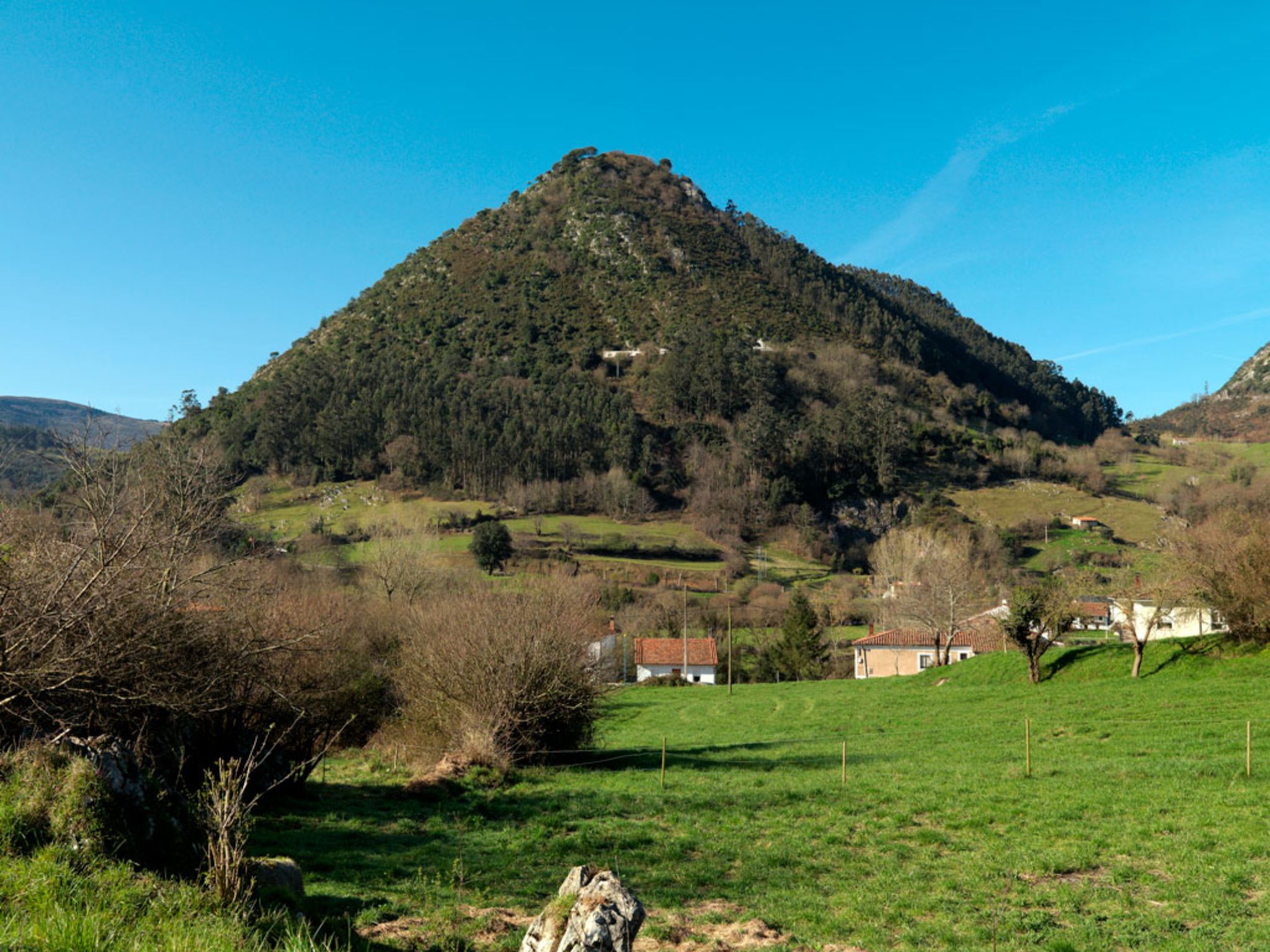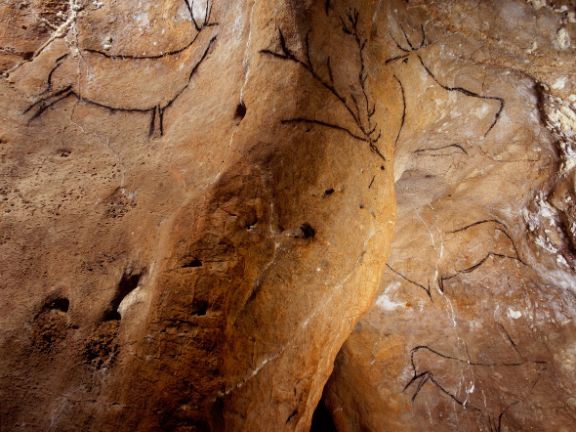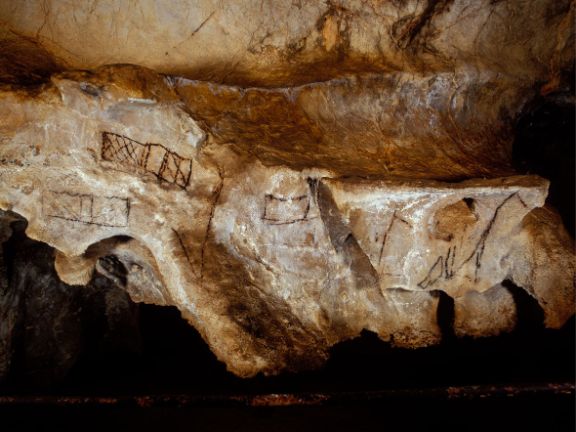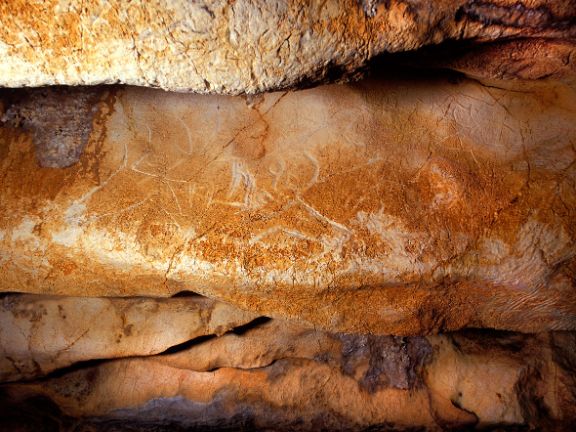Las Chimeneas Cave

Identification of the Property
SubirMonte Castillo, Puente Viesgo, Autonomous Community of Cantabria
Access
On the N-623 road, turn off in the centre of the town of Puente Viesgo, go past the car park and take the road up the hill to Monte Castillo. This ends at the car park for visitors; from there walk up to reception and the interpretation centre, located outside the entrance to El Castillo Cave.
Geographical coordinates
UTM 30T 421890E / 4793800N Z: 190
Description
SubirTopographic description
Monte Castillo is a conical limestone hill, forming the easternmost spur of Sierra del Escudo de Cabuérniga, a feature separating the coastal lowlands from the interior valleys in the west of Cantabria. It stands over the left bank of the River Pas, dominating a wide fluvial plain at the start of the “lower Pas Valley” and also the natural route from this area to Besaya valley.
The cave has developed on two different levels and has a maximum depth of -21m. The lower level corresponds to the area used by the Palaeolithic artists, and its original entrance must preserve the remains of an archaeological deposit, beneath the boulders, calcite and stalagmites that sealed it completely. This lower passage runs north-south, with a width of 5m in its narrowest sections, between chambers and sidepassages, until its reaches the largest area, known as Chamber B, where the cave art is situated. Other smaller galleries and the end passage lead off from this chamber. This lower series is now reached by a series of steps from the upper passage, which has no archaeological interest, and which connects with the lower passage through a number of vertical shafts. It is the longest cave in Monte Castillo, with a length of 798m.
Date of Discovery
This prehistoric site was discovered by the engineer A. García Lorenzo in September 1953. Fissures developed along a fault on the side of the hill were dug out in order to reach the cave, which had no known entrance at that time.
Archaeological research
A study of the prehistoric art inside the cave was made in the same year of its discovery, when mention was made of the possible existence of an archaeological deposit beneath the calcite layers.
In the 1960s, J. González Echegaray carried out trial excavations next to the original entrance to the lower passage and in the chamber containing the paintings, but with few results of any interest. No archaeological deposit has been identified in the cave, apart from a few remains of mammals and lithic implements. Pigment samples of paintings were taken for absolute dating by the AMS 14C technique, with the following results: Stag, figure No. 20: (GifA95194) 15,070 ± 140 BP Lines on the Panel of Signs, No. 14: (GifA-95230) 13,949 ± 140 BP.
 Pulse para ampliar
Pulse para ampliar
 Pulse para ampliar
Pulse para ampliar
 Pulse para ampliar
Pulse para ampliar
Artistic contents: paintings and engravings
The art in the cave can be grouped into two series, based on the techniques used (engraving, painting) and the topographical distribution of the depictions. The engravings are located, in general, near the original entrance to the cave, on both walls and on the roof.
The engraving techniques are restricted to finger-produced drawings and incised lines that represent simple 14 outlines. Remains of black paint are only seen in part of one figure. The figures are distributed longitudinally, because of the small available space, except in one panel where they accumulate in numerous superimpositions.
The main ensemble of engravings is located at the end of the main passage, where several panels contain numerous depictions of animals: aurochsen, cervids, chamois, and possible ibex. The hind-quarters of another animal could belong to a horse. Together with these figures, groups of lines, drawn singly or in groups, are more difficult to interpret.
The paintings are found further back in this sector of the cave, grouped on a section of wall and in a short, narrow passage. The painting style represents the animals as simple outlines, always drawn with black pigment. The main animal figures are five stags, some of which are incomplete. Their antlers are depicted in twisted perspective and their bodies show no internal divisions or details. A horse's head is also depicted. Another painting of the same characteristics, representing an ibex, is located in the main chamber.
The other paintings are a group of signs, including rectangles with no interior lines and other more complex quadrilaterals divided internally into three. Other lines and marks are associated with these signs.
Bibliography
SubirGONZÁLEZ ECHEGARAY, J., 1974. Pinturas y grabados de la Cueva de las Chimeneas (Puente Viesgo, Santander). Monografías de Arte Rupestre, Arte Paleolítico 2. Barcelona.
MOURE, A., GONZÁLEZ SÁINZ, C., BERNALDO DE QUIRÓS, F., CABRERA, V., 1996. Dataciones absolutas de pigmentos en cuevas cantábricas: Altamira, El Castillo, Chimeneas y Las Monedas. En A. Moure (Ed.), "El hombre fósil" 80 años después: 315-320. Santander: Universidad de Cantabria, Fundación Marcelino Botín, Institute for Prehistoric Investigations.
ONTAÑÓN PEREDO, R. 2018. 10 Cuevas Patrimonio Mundial en Cantabria. Santander: Consejería de Educación, Cultura y Deporte - Gobierno de Cantabria / Asociación de Amigos del MUPAC.



